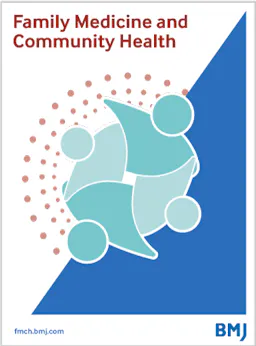Liver abnormalities following SARS-CoV-2 infection in children 1 to 10 years of age
IF 4.3
3区 医学
Q1 PRIMARY HEALTH CARE
引用次数: 0
Abstract
Objective Beginning in October 2021 in the USA and elsewhere, cases of severe paediatric hepatitis of unknown aetiology were identified in young children. While the adenovirus and adenovirus-associated virus have emerged as leading aetiological suspects, we attempted to investigate a potential role for SARS-CoV-2 in the development of subsequent liver abnormalities. Design We conducted a study using retrospective cohorts of deidentified, aggregated data from the electronic health records of over 100 million patients contributed by US healthcare organisations. Results Compared with propensity score matched children with other respiratory infections, children aged 1–10 years with COVID-19 had a higher risk of elevated transaminases (HR (95% CI) 2.16 (1.74 to 2.69)) or total bilirubin (HR (95% CI) 3.02 (1.91 to 4.78)), or new diagnoses of liver diseases (HR (95% CI) 1.67 (1.21 to 2.30)) from 1 to 6 months after infection. Patients with pre-existing liver abnormalities, liver abnormalities surrounding acute infection, younger age (1–4 years) or illness requiring hospitalisation all had similarly elevated risk. Children who developed liver abnormalities following COVID-19 had more pre-existing conditions than those who developed abnormalities following other infections. Conclusion These results indicate that SARS-CoV-2 may prime the patient for subsequent development of liver infections or non-infectious liver diseases. While rare (~1 in 1000), SARS-CoV-2 is a risk for subsequent abnormalities in liver function or the diagnosis of diseases of the liver. No data are available. We used a cloud-based database and cannot download the data set. In addition, the database is constantly being upgraded with new information, so the actual data from which the analysis was done will not be available at a subsequent time. That is why we indicate when the database was accessed and which specific data set was used. The EMR data are deidentified and so individual data cannot be made available to us or anyone else.1 至 10 岁儿童感染 SARS-CoV-2 后出现肝脏异常
目的 从 2021 年 10 月开始,在美国和其他地区发现了病因不明的重症小儿肝炎病例。虽然腺病毒和腺病毒相关病毒已成为主要的病因,但我们试图研究 SARS-CoV-2 在随后的肝脏异常发展中可能扮演的角色。设计 我们利用美国医疗机构提供的超过 1 亿名患者的电子健康记录中的去标识化汇总数据进行了一项回顾性队列研究。结果 与倾向得分匹配的其他呼吸道感染儿童相比,感染 COVID-19 的 1-10 岁儿童在感染后 1-6 个月内转氨酶升高(HR (95% CI) 2.16 (1.74 to 2.69))或总胆红素升高(HR (95% CI) 3.02 (1.91 to 4.78))或新诊断肝病(HR (95% CI) 1.67 (1.21 to 2.30))的风险更高。原有肝功能异常、急性感染时肝功能异常、年龄较小(1-4 岁)或需要住院治疗的患者的风险也同样升高。与感染其他疾病后出现肝功能异常的儿童相比,感染 COVID-19 后出现肝功能异常的儿童的原有病症更多。结论 这些结果表明,SARS-CoV-2 可能为患者日后患上肝脏感染或非感染性肝病埋下隐患。SARS-CoV-2虽然罕见(约为千分之一),但却有可能导致随后的肝功能异常或肝脏疾病诊断。目前尚无相关数据。我们使用的是云数据库,无法下载数据集。此外,数据库还在不断更新,因此分析所依据的实际数据在随后的时间里将无法获得。因此,我们会注明访问数据库的时间以及使用的具体数据集。EMR 数据是去标识化的,因此无法向我们或其他任何人提供个人数据。
本文章由计算机程序翻译,如有差异,请以英文原文为准。
求助全文
约1分钟内获得全文
求助全文
来源期刊

Family Medicine and Community Health
PRIMARY HEALTH CARE-
CiteScore
9.70
自引率
0.00%
发文量
27
审稿时长
19 weeks
期刊介绍:
Family Medicine and Community Health (FMCH) is a peer-reviewed, open-access journal focusing on the topics of family medicine, general practice and community health. FMCH strives to be a leading international journal that promotes ‘Health Care for All’ through disseminating novel knowledge and best practices in primary care, family medicine, and community health. FMCH publishes original research, review, methodology, commentary, reflection, and case-study from the lens of population health. FMCH’s Asian Focus section features reports of family medicine development in the Asia-pacific region. FMCH aims to be an exemplary forum for the timely communication of medical knowledge and skills with the goal of promoting improved health care through the practice of family and community-based medicine globally. FMCH aims to serve a diverse audience including researchers, educators, policymakers and leaders of family medicine and community health. We also aim to provide content relevant for researchers working on population health, epidemiology, public policy, disease control and management, preventative medicine and disease burden. FMCH does not impose any article processing charges (APC) or submission charges.
 求助内容:
求助内容: 应助结果提醒方式:
应助结果提醒方式:


